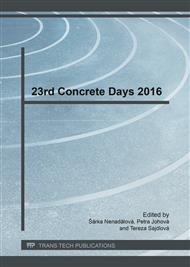p.130
p.135
p.140
p.146
p.152
p.158
p.164
p.173
p.178
Non-Linear FEM Analysis of Integral Bridges Transition Area
Abstract:
The transition area of bridges is non-homogeneous solid, which consists of soil embankment, transition slab and roadway layers. These transition area elements consist of various materials with different properties. Besides the imposed loads, behavior of these areas is significantly affected by uneven settlement between the bridge abutment and soil embankment. In case of integral bridges horizontal movements of a bridge caused mostly by temperature and ongoing rheological phenomena in concrete have to be taken into account. This leads to abutment deformation in combination with time dependent soil consolidation it results in varying earth pressure over the bridges lifetime together with cyclic horizontal movements of the pavement resulting in its cracks and excessive deformations. In this paper, comparison of different approaches to finite element analysis of transition areas is presented. First analysis was performed using area elements to represent the bridge structure, and volume elements to represent embankment, while second analysis was performed in more conservative way using spring based method proposed by Křížek [3], as representation of the surrounding soil. Results obtained via both methods are compared with each other as well as with data obtained from experimental measurment of a transition area conducted in Switzerland [1].
Info:
Periodical:
Pages:
152-157
Citation:
Online since:
May 2017
Authors:
Keywords:
Price:
Сopyright:
© 2017 Trans Tech Publications Ltd. All Rights Reserved
Share:
Citation:


